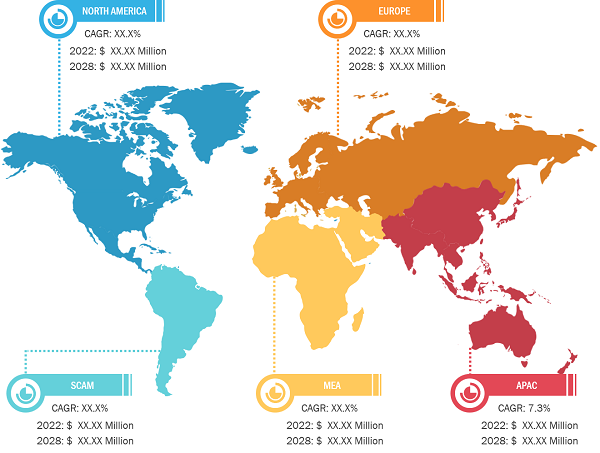Treatment, by Product Type, to Dominate Implantable Medical Devices During 2022–2030
According to our new research study on "Implantable Medical Devices Market Size and Forecast (2020–2030), Global and Regional Share, Trends, and Growth Opportunity Analysis," the market is expected to grow from US$ 80,156.0 million in 2022 and is expected to reach a value of US$ 138,474.35 million by 2030; it is anticipated to record a CAGR of 7.1% from 2022 to 2030. Key factors driving the implantable medical devices market growth are growing areas of application of implantable medical devices and rising cases of spinal cord injury.
According to the WHO, in 2022, the US recorded 50 million epilepsy cases; 1 billion migraine cases; and 400,000 spinal cord injury cases. Spinal cord stimulation is one of the most preferred techniques in treating chronic back pain, primarily due to the anatomical and functional abilities of the spinal cord nerves to control the sensation of pain. The incidence of spinal cord injuries has rapidly increased over the past decade. The National Spinal Cord Injury Statistical Center (NSCISC) 2021 fact sheet states that the annual incidence of spinal cord injuries is 60 cases per million. According to the article "Epidemiology of traumatic spinal cord injuries: a large population-based study," published in April 2022, the overall age-sex standardized incidence rate of traumatic spinal cord injuries was 26.5 per 1 million population, and the rates were directly related to age in both sexes, in 2021. According to the same source, in the elderly population (65 years or older), the rate is 59.2 and 23.3 per 1 million in males and females, respectively. Spinal cord stimulators are widely used for managing postoperative pain associated with spinal surgery. According to the report titled "Spinal Cord Injury Facts and Stats,” in 2021, ∼17,700 Americans suffer from a spinal cord injury yearly, of which ∼78% are men of an average age of 43. Therefore, the high incidence of spinal cord injuries in the geriatric population and adults fuels the demand for implantable neurostimulation devices, boosting the market growth.
Implantable Medical Devices Market, by Geography, 2022 (%)
Implantable Medical Devices Market Size and Forecasts (2020 - 2030), Global and Regional Share, Trends, and Growth Opportunity Analysis Report Coverage: By Nature Type (Active Implant and Passive Implant), Product Type (Diagnostics and Treatment), Material Type (Metallic, Ceramic, and Polymers), Application (Orthopedic Implants, Cardiovascular Implants, Breast Implants, Brain Implants, and Others), and End Users (Hospitals, Specialty Clinics, ASCs, and Others)
Implantable Medical Devices Market SWOT Analysis by 2030
Download Free Sample
Source: The Insight Partners Analysis
Abbott Laboratories, Boston Scientific Corp, Dentsply Sirona Inc, Johnson & Johnson, Medtronic Plc, Institut Straumann AG, Smith & Nephew Plc, BIOTRONIK SE & Co KG, LivaNova Plc, and MED-EL Elektromedizin Gerate GmbH are among the key companies operating in the implantable medical devices market. The companies have been implementing various strategies that contributed to their growth and led to various changes in the market. The companies have utilized organic strategies (such as launches, expansion, and product approvals) and inorganic strategies (such as product launches, collaboration, and partnerships).
For instance, in August 2023, Medtronic plc received CE (Conformite Europeenne) Mark approval for its Inceptiv closed-loop rechargeable spinal cord stimulator (SCS). It is the first Medtronic SCS device to offer a closed-loop feature that senses each person's unique biological signals and adjusts stimulation moment to moment, as needed, to keep therapy in harmony with the motions of daily life.
The report segments the implantable medical devices market as follows:
The global implantable medical devices market is categorized on the basis of nature type, product type, material type, application, and end user. By nature type, the implantable medical devices market is bifurcated into active implant and passive implant. The passive implant segment held a larger market share in 2022. However, the active implant segment is anticipated to record a higher CAGR during the forecast period. Passive implants do not have any electronic or magnetic components, and they do not require any external power source to function. A few examples of passive implants include catheters, electric leads, aneurysm clips, stents, external fixation devices, hip prostheses, and inferior vena cava (IVC) filters. MRI may affect passive implants through heating, rotation, displacement, and magnetization mechanisms.
Based on product type, the implantable medical devices is bifurcated into diagnostics and treatment. The market is segmented into metallic, ceramics, and polymers based on material type. In terms of application, the implantable medical devices market is segmented into cardiovascular implants, orthopedic implants, cardiovascular implants, breast implants, prosthetics implants, brain implants, and others. In terms of end user, the market is categorized into hospitals, specialty clinics, ASCs, and others.
The implantable medical devices market, based on geography, is segmented into North America (US, Canada, and Mexico), Europe (Germany, France, Italy, UK, Russia, and Rest of Europe), Asia Pacific (Australia, China, Japan, India, South Korea, and Rest of Asia Pacific), Middle East & Africa (South Africa, Saudi Arabia, UAE, and Rest of Middle East & Africa), and South & Central America (Brazil, Argentina, and Rest of South & Central America).
Contact Us
Phone: +1-646-491-9876
Email Id: sales@theinsightpartners.com